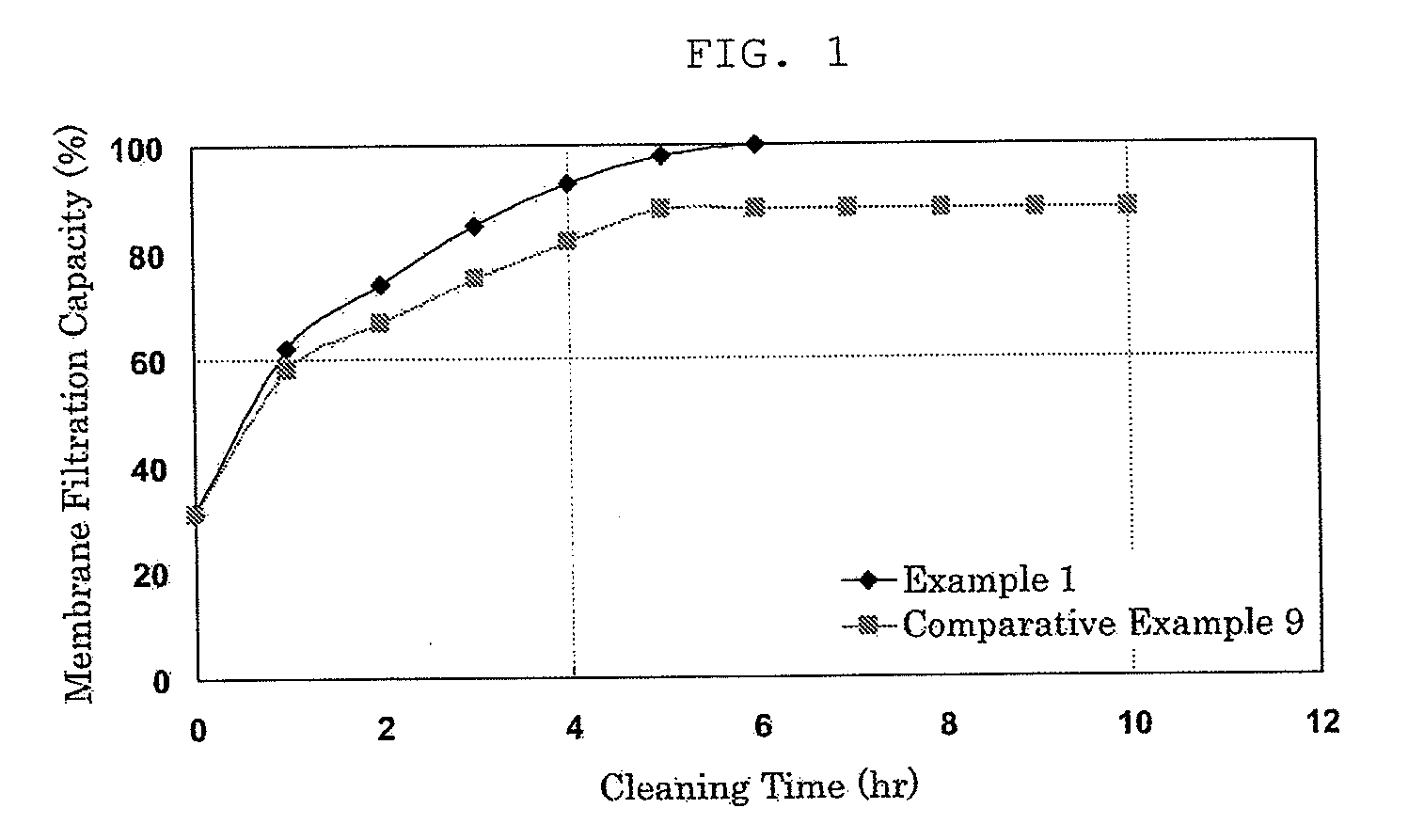Cleaning agent for separation membrane, process for preparing the cleaning agent, and cleaning method
a technology of cleaning agent and separation membrane, which is applied in the preparation of inorganic non-surface active detergent compositions, detergent compounding agents, detergent mixture compositions, etc., can solve the problems of inability to remove film fouling substances, and inability to clean for a long time. to achieve the effect of reducing time and the amount of water needed for cleaning, equal or superior cleaning effect, and high cleaning
- Summary
- Abstract
- Description
- Claims
- Application Information
AI Technical Summary
Benefits of technology
Problems solved by technology
Method used
Image
Examples
example 1
[0054]A membrane module whose transmembrane pressure difference reached 200 kPa after 6-month operation using, as raw water, surface water of river having a turbidity of from 1 to 5 mg / L (based on the kaolin standard solution produced by Kanto Chemical) and a total organic carbon (TOC) of from 0.5 mg / L to 1.5 mg / L was cleaned as described below.
[0055]A cleaning solution was prepared by adding, to an aqueous hydrogen peroxide solution (0.88 mol / L), ferrous chloride and malic acid to give concentrations of 0.0008 mol / L and 0.05 mol / L, respectively. The membrane module was subjected to recycle filtration cleaning with it for 6 hours. The cleaning solution was then removed from the module and the separation membrane was rinsed with 500 L of ultrafiltration water for 2.5 hours.
[0056]As a result of the cleaning by the above-described method, supposing that the membrane filtration capacity before use was 100%, the membrane recovered 100% of the membrane filtration capacity which had once r...
example 2
[0058]For cleaning the fouled membrane module of Example 1, a cleaning solution was prepared by adding, to an aqueous hydrogen peroxide solution (0.88 mol / L), ferrous chloride and tartaric acid to give concentrations of 0.0008 mol / L and 0.05 mol / L, respectively. The membrane module was subjected to recycle filtration cleaning with it for 6 hours. The cleaning solution was then removed from the module and the separation membrane was rinsed with 500 L of ultrafiltration water for 2.5 hours.
[0059]As a result of the cleaning by the above-described method, supposing that the membrane filtration capacity before use was 100%, the membrane recovered 100% of the membrane filtration capacity which had once reduced to 10% of it before cleaning. The total cleaning time in this cleaning method was 8.5 hours. During cleaning, generation of neither a chlorine gas nor reaction heat was observed.
[0060]The cleaning allowed filtration operation through the resulting membrane for further 6 months.
example 3
[0061]For cleaning the fouled membrane module of Example 1, a cleaning solution was prepared by adding, to an aqueous hydrogen peroxide solution (0.88 mol / L), ferrous chloride and tartronic acid to give concentrations of 0.0008 mol / L and 0.05 mol / L, respectively. The membrane module was subjected to recycle filtration cleaning with it for 6 hours. The cleaning solution was then removed from the module and the separation membrane was rinsed with 500 L of ultrafiltration water for 2.5 hours.
[0062]As a result of the cleaning by the above-described method, supposing that the membrane filtration capacity before use was 100%, the membrane recovered 100% of the membrane filtration capacity which had once reduced to 10% of it before cleaning. The total cleaning time in this cleaning method was 8.5 hours. During cleaning, generation of neither a chlorine gas nor reaction heat was observed.
[0063]The cleaning allowed filtration operation through the resulting membrane for further 6 months.
PUM
| Property | Measurement | Unit |
|---|---|---|
| pore size | aaaaa | aaaaa |
| diameter | aaaaa | aaaaa |
| length | aaaaa | aaaaa |
Abstract
Description
Claims
Application Information
 Login to View More
Login to View More - R&D Engineer
- R&D Manager
- IP Professional
- Industry Leading Data Capabilities
- Powerful AI technology
- Patent DNA Extraction
Browse by: Latest US Patents, China's latest patents, Technical Efficacy Thesaurus, Application Domain, Technology Topic, Popular Technical Reports.
© 2024 PatSnap. All rights reserved.Legal|Privacy policy|Modern Slavery Act Transparency Statement|Sitemap|About US| Contact US: help@patsnap.com









